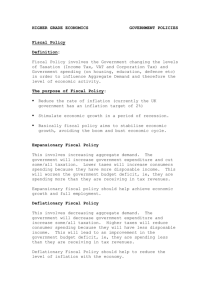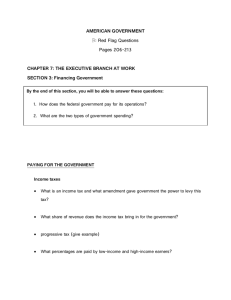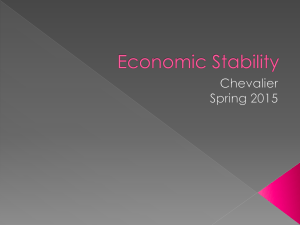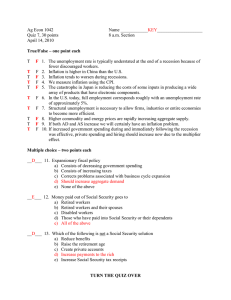File - Interesting Economics
advertisement
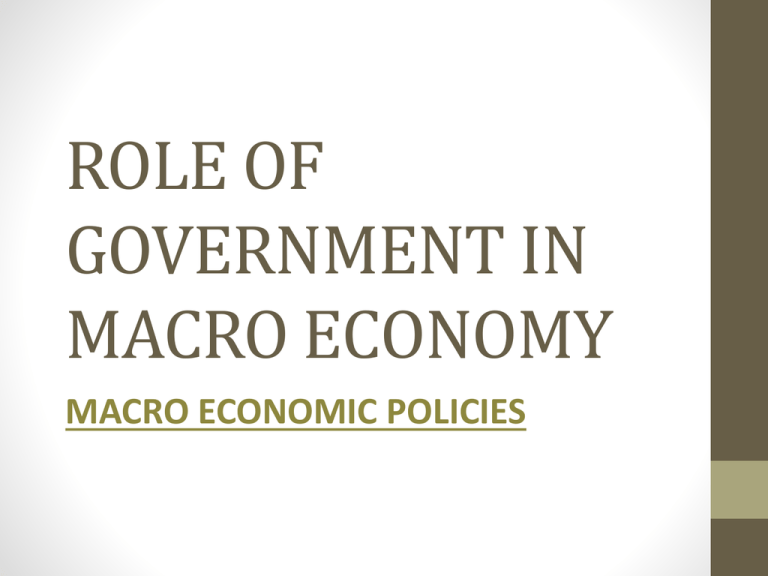
ROLE OF GOVERNMENT IN MACRO ECONOMY MACRO ECONOMIC POLICIES LEARNING OBJECTIVES • Describe each type of policy - Monetary - Fiscal - Supply side • Give examples of each REVIEW… The main macro economic objectives of the government include: * Higher economic growth • * Low inflation • * Low Unemployment * Balance of payments equilibrium Economic Indicators GOALS Higher economic growth Low Inflation Low Unemployment Positive Balance of Payments INDICATORS Macro-economic policy • Is drawn up by government • Are tools used to influence the country’s economy • OBJECTIVE: > GDP growth > Low inflation > Low unemployment GROUP TASK • Can you find a suitable description and some examples of each of these policies? 1) MONETARY POLICY 2) FISCAL POLICY 3) SUPPLY SIDE POLICY TYPES OF POLICY TOOLS • Fiscal policy, which involves changes in taxation or government spending. • Monetary policy, which involves changes in interest rates or the supply of money. • DEMAND SIDE POLICIES TYPES OF POLICY TOOLS * Improving competition • SUPPLY and efficiency in product SIDE and factor markets. POLICIES • Providing incentives for households to work or save. * Providing incentives for firms to produce and invest. MONETARY POLICY • Monetary policy is carried out by the Central Bank / Monetary authorities •So how does this work??? MONETARY POLICY • Monetary policy relates to the supply of money • It is controlled by factors like: a) interest rates b) Reserve Requirements (CRR) •EXAMPLE • To control high inflation, policy-makers (CENTRAL BANK) can raise interest rates thereby reducing money supply. MONETARY POLICY • Monetary policy involves influencing the money supply. MONETARY POLICY Interest rate MONEY SUPPLY HOW MONETARY POLICY WORKS !!! • Central Bank sets an inflation target • If inflation is ABOVE 2%... They increase interest rates • increase borrowing costs • reduce consumer spending lower aggregate demand and lower inflation. INFLATION RATE MONETARY POLICY • Interest rates are set so that the inflation target can be met in the future. • It takes up to two years for a rate change to affect inflation EFFECT OF INTEREST RATE CHANGES INTEREST RATE CHANGES AFFECT: How? • Households • Business • Consumer and business confidence • Asset values • Exchange rates DECREASING INTEREST RATES • • Will discourage saving • Will encourage household spending • Will increase AD AS AD2 AD1 • What about Price??? FISCAL POLICY • Fiscal Policy is carried out by the government and involves changing: • Level of government spending • Levels of taxation FISCAL POLICY DESCRIPTION • Fiscal policy relates to: a) government spending b) revenue collection. •EXAMPLE • WHEN DEMAND IS LOW in the economy, the government can increase its spending to stimulate (increase) demand. • OR • it can lower taxes to increase disposable income for people and firms. FISCAL POLICY • To increase demand and economic growth, the government will cut tax and increase spending (leading to a higher budget deficit) SO … • Fiscal policy involves the government changing the levels of taxation and government spending Why ? ….. to influence Aggregate Demand (AD) and the level of economic activity. PAIRED TASK Using a diagram is the effect of an Increase/ decrease in tax? FISCAL POLICY EXPANSIONARY • This involves increasing AD • Therefore the government will increase spending (G) and / or cut taxes (T). increase consumers spending • Lower taxes will because they have more disposable income (C) • This will tend worsen the government budget deficit and the government will need to increase borrowing. FISCAL POLICY DEFLATIONARY • • This involves decreasing AD. • Therefore the government will cut government spending (G) and / or increase taxes. • Higher taxes will reduce consumer spending (C) • Tight fiscal policy will tend to cause an improvement in the government budget deficit. HOW IT WORKS/ • When inflation is too strong, the economy may need a slowdown. In such a situation, a government can use fiscal policy to increase taxes to suck money out of the economy. High inflation T A X WHICH IS MORE EFFECTIVE? • MONETARY POLICY Refer to the worksheet and complete the task. FISCAL POLICY MONETARY vs FISCAL • Monetary policy is quicker to implement. (Interest rates can be set every month). • A decision to increase government spending may take time to decide where to spend the money. SUPPLY SIDE POLICY • Is used when more employment is needed. • Refers to factors affecting the quantity or quality of goods and services produced by an economy • Supply-side policies are mainly microeconomic policies designed to make markets and industries operate more efficiently AIM… • Achieve economic growth • Stabilise the economy • SUPPLY SIDE OBJECTIVES • invest in people’s skills • Increase labour and capital productivity • Increase mobility of labour • Increase capital investment • Increase research and development spending by firms • Promoting more competition • Encourage the start-up and expansion of new business EFFECT OF INCREASE IN A’S’ • illustrates a simplified macroeconomic equilibrium: Increase in AS • aggregate demandand aggregate supply intersect = overall price and output levels) an increase in supply (i.e. production of goods and services) will increase output and lower prices. So what are supply side policies? • are government policies to improve the supply side of the economy in the long term • They improve the productive potential of the economy. Read more at http://www.s-cool.co.uk/alevel/economics/aggregate-demand-and-aggregate-supply/reviseit/supply-side-policies#FkjhBVUCvkwqF7Ev.99 INCREASE IN AGGREGATE SUPPLY • • Prices will decrease • Unemployment will decrease • Productivity will increase SUMMARY All 3 work together SUPPLY SIDE

